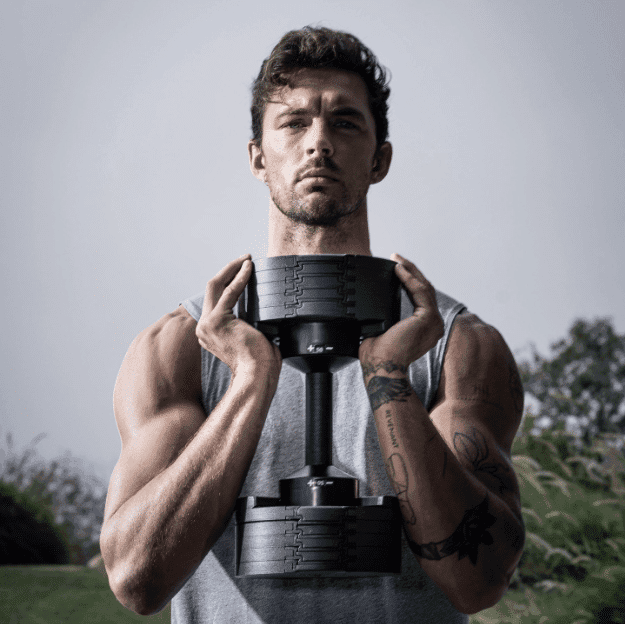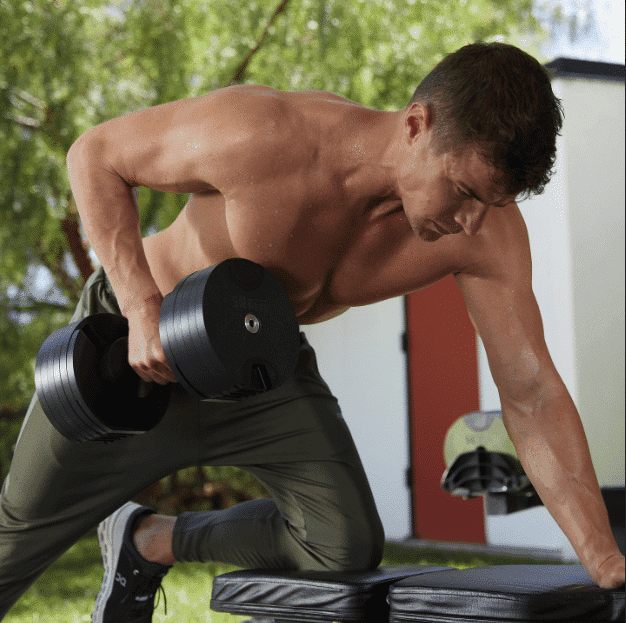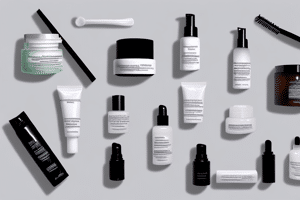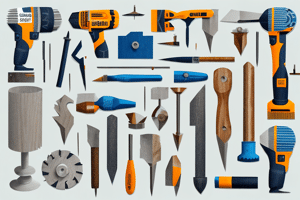UPDATED: May 09, 2023
Are you looking for an effective full-body workout routine that you can do at home with ease? Adjustable dumbbell workouts might be just what you need! In this article, we'll take you through everything you need to know about adjustable dumbbell workouts, including the benefits of using this equipment, how to choose the right weights and safety tips to follow during a workout routine.
Understanding Adjustable Dumbbells
Adjustable dumbbells are a game-changer when it comes to working out at home. These versatile pieces of equipment allow you to change the weight according to your fitness level, making them ideal for beginners and advanced fitness enthusiasts alike.
With adjustable dumbbells, you can easily adjust the plates with a simple turn of the dial or slide of a pin to increase or decrease the weight. This feature makes it easy to switch between exercises and adjust the weight to suit your needs.
Whether you're looking to build strength, endurance, or muscle mass, adjustable dumbbells are an excellent choice. They provide a full-body workout, allowing you to target multiple muscle groups, including your arms, chest, shoulders, back, legs, and abs.
Benefits of Adjustable Dumbbells
There are several advantages to using adjustable dumbbells over traditional dumbbells. The primary benefit is that you can perform a variety of exercises using a single set of weights, saving you money and space.
With adjustable dumbbells, you'll be able to work out at home without needing to invest in multiple sets of weights or bulky equipment. This makes it easy to stay consistent with your workouts and achieve your fitness goals.
Another benefit of adjustable dumbbells is that they allow you to make small weight adjustments, which can be beneficial for building strength and muscle mass. Small weight increments are also useful for those who are recovering from an injury or have limited mobility.

How to Choose the Right Adjustable Dumbbells
When choosing adjustable dumbbells, there are a few factors to consider. The first is the range of weight that the set provides. Look for a set that offers a wide range of weights, from light to heavy, so that you can progress as you get stronger.
The second factor to consider is the increments in which the weight can be increased or decreased. Look for a set that allows you to make small weight adjustments, as this will give you more control over your workouts.
Finally, consider the quality of the materials. A good set of adjustable dumbbells will last longer and provide reliable performance, saving you money in the long run. Look for dumbbells made from high-quality materials, such as steel or cast iron, with a durable coating to prevent rust and wear.
Overall, adjustable dumbbells are an excellent investment for anyone looking to work out at home. With their versatility, convenience, and effectiveness, they are sure to help you achieve your fitness goals.
Adjustable Dumbbell Workouts: Safety Tips
Before diving into your adjustable dumbbell workouts, it's essential to learn some critical safety tips to prevent injury and ensure maximum results. However, safety isn't the only thing to consider when working out with dumbbells. You also want to make sure that you're getting the most out of your workout by using proper form and technique.
Proper Form and Technique
When using dumbbells for your workout, always practice proper form and technique to get the most out of your training. Make sure to hold each dumbbell with a firm grip, keep a stable stance, and perform each exercise in a slow and controlled manner. By doing so, you'll engage the targeted muscle groups more effectively and reduce the risk of injury.
Another essential aspect of proper form is maintaining good posture throughout your workout. Keep your back straight, shoulders back, and head up to prevent straining your neck or back muscles. If you're unsure about proper form, consider working with a personal trainer or watching instructional videos online.
Avoiding Common Injuries
One of the most common injuries associated with dumbbell workouts is muscle strain. To avoid this, it's crucial to start with lighter weights and gradually increase the load as your muscles become stronger. Additionally, allow yourself enough rest time between sets and make sure to stretch before and after each workout. Doing so will help you prevent injuries and improve flexibility.
Another common injury associated with dumbbell workouts is rotator cuff strain. This type of injury occurs when the muscles and tendons around the shoulder joint become inflamed or torn. To prevent rotator cuff strain, make sure to warm up your shoulder muscles before each workout and avoid overloading your shoulders with too much weight.
Finally, it's important to listen to your body during your workout. If you experience any pain or discomfort, stop immediately and seek medical attention if necessary. Pushing through the pain can lead to more severe injuries and setbacks in your fitness journey.
By following these safety tips and using proper form and technique, you can get the most out of your dumbbell workouts while reducing the risk of injury. Remember to start slowly, gradually increase your weights, and listen to your body to achieve your fitness goals safely and effectively.
Find Your Perfect Adjustable Dumbbell
Want to try these workouts? Find the perfect adjustable dumbbell for you by checking out our list of the 3 Best Adjustable Dumbbells for 2023 here!
Adjustable Dumbbell Workouts: Beginner Full-Body Dumbbell Workout
Are you new to working out with adjustable dumbbells? Here's a beginner-friendly full-body workout routine to get you started:
Warm-Up Exercises
Before starting any workout, it's essential to warm up your body. Warm-up exercises help to increase blood flow, loosen up your muscles, and prevent injuries. Here are three warm-up exercises you can do:
- Jumping Jacks - 15 reps
- Bodyweight Squats - 10 reps
- Arm Circles - 10 reps (forward and backward)
Workout Routine
Now that you're warmed up let's move on to the workout routine. Do each exercise for 15 reps and repeat the circuit three times.
- Dumbbell Squats - Start with your feet shoulder-width apart and hold the dumbbells at your sides. Bend your knees and lower your body until your thighs are parallel to the ground. Push through your heels to stand back up.
- Dumbbell Shoulder Presses - Stand with your feet shoulder-width apart and hold the dumbbells at shoulder height. Press the dumbbells up until your arms are fully extended, then lower them back down.
- Dumbbell Deadlifts - Stand with your feet shoulder-width apart and hold the dumbbells in front of your thighs. Hinge at your hips and lower the dumbbells towards the ground, keeping your back straight. Stand back up, squeezing your glutes at the top.
- Dumbbell Bicep Curls - Stand with your feet shoulder-width apart and hold the dumbbells at your sides. Curl the dumbbells towards your shoulders, then lower them back down.
- Dumbbell Tricep Extensions - Stand with your feet shoulder-width apart and hold the dumbbells overhead. Lower the dumbbells behind your head, keeping your elbows close to your ears. Extend your arms back up to the starting position.
- Dumbbell Chest Presses - Lie on your back on a bench or the ground with your feet flat on the floor. Hold the dumbbells at chest height and press them up towards the ceiling, then lower them back down.
- Crunches - Lie on your back on the ground with your knees bent and feet flat on the floor. Place your hands behind your head and lift your shoulders off the ground, squeezing your abs at the top.
- Planks - Hold for 30 seconds - Start in a push-up position, but instead of lowering yourself to the ground, hold yourself up on your forearms. Keep your body in a straight line from your head to your heels, engaging your core muscles.
Cool-Down and Stretching
Now that you've completed the workout, it's time to cool down and stretch your muscles. Cooling down helps to gradually decrease your heart rate and prevent dizziness or fainting. Spend a few minutes walking at a moderate pace to bring your heart rate down. Then, take some time to stretch your muscles. Stretching helps to improve flexibility, reduce muscle soreness, and prevent injuries. Here are some stretches you can do:
- Hamstring Stretch - Sit on the ground with one leg straight out in front of you and the other bent. Reach forward towards your toes, feeling the stretch in the back of your leg. Switch legs and repeat.
- Quad Stretch - Stand with your feet hip-width apart and bend one knee, bringing your heel towards your buttocks. Hold onto your ankle with one hand and pull it towards your buttocks until you feel the stretch in the front of your thigh. Switch legs and repeat.
- Shoulder Stretch - Stand with your feet hip-width apart and bring one arm across your chest. Hold onto your elbow with the opposite hand and gently pull your arm towards your chest until you feel the stretch in your shoulder. Switch arms and repeat.
Remember to listen to your body and take breaks if needed. With consistency and dedication, you'll be able to increase the weight of your dumbbells and see progress in your fitness journey. Happy lifting!

Adjustable Dumbbell Workouts: Intermediate Full-Body Dumbbell Workout
Once you're comfortable with the beginner workout routine, it's time to step it up a notch. Here's an intermediate full-body workout routine that will challenge you and help you build muscle:
Warm-Up Exercises
Before you start your workout, it's important to warm up your muscles to prevent injury. Here are some warm-up exercises you can do:
- Jumping Jacks - 20 reps
- Bodyweight Squats - 15 reps
- Arm Circles - 15 reps (forward and backward)
These exercises will get your heart rate up and help you prepare for the workout ahead.
Workout Routine
For this workout routine, you'll need a set of dumbbells. Do each exercise for 12 reps and repeat the circuit four times.
- Dumbbell Lunges: Stand with your feet shoulder-width apart and hold a dumbbell in each hand. Step forward with one foot and lower your body until your front knee is bent at a 90-degree angle. Return to the starting position and repeat with the other leg.
- Dumbbell Bent-Over Rows: Hold a dumbbell in each hand and bend forward at the waist. Keep your back straight and lift the dumbbells toward your chest, squeezing your shoulder blades together. Lower the dumbbells back down and repeat.
- Dumbbell Flys: Lie on your back with a dumbbell in each hand. Extend your arms above your chest and lower the dumbbells out to the sides, keeping your elbows slightly bent. Return to the starting position and repeat.
- Dumbbell Hammer Curls: Hold a dumbbell in each hand with your palms facing in. Curl the dumbbells up toward your shoulders, keeping your elbows close to your body. Lower the dumbbells back down and repeat.
- Overhead Tricep Extensions: Hold a dumbbell in both hands and extend your arms above your head. Lower the dumbbell behind your head, bending your elbows. Extend your arms back up and repeat.
- Dumbbell Bulgarian Split Squats: Stand facing away from a bench or chair with a dumbbell in each hand. Place one foot on the bench or chair behind you and lower your body until your front knee is bent at a 90-degree angle. Return to the starting position and repeat with the other leg.
- Toe Touches: Stand with your feet shoulder-width apart and hold a dumbbell in each hand. Bend forward at the waist and touch your toes with the dumbbells. Return to the starting position and repeat.
- Isometric Plank Hold: Get into a plank position with your forearms on the ground and your body in a straight line. Hold this position for 45 seconds.
These exercises will work your entire body and help you build strength and endurance.
Find Your Perfect Adjustable Dumbbell
Want to try these workouts? Find the perfect adjustable dumbbell for you by checking out our list of the 3 Best Adjustable Dumbbells for 2023 here!
Cool-Down and Stretching
After your workout, take some time to stretch each muscle group, and allow your heart rate to come down gradually. Cooling down after an intense workout prevents blood pooling and helps you reduce muscle soreness. Here are some stretches you can do:
- Quad Stretch - Stand with your feet shoulder-width apart and lift one foot behind you, holding onto your ankle. Pull your heel toward your buttocks until you feel a stretch in your quadriceps. Hold for 30 seconds and repeat with the other leg.
- Hamstring Stretch - Sit on the ground with your legs extended in front of you. Reach forward and try to touch your toes, keeping your back straight. Hold for 30 seconds.
- Chest Stretch - Stand with your feet shoulder-width apart and clasp your hands behind your back. Lift your arms up and back, squeezing your shoulder blades together. Hold for 30 seconds.
- Tricep Stretch - Raise one arm above your head and bend your elbow, placing your hand behind your neck. Use your other hand to gently push your elbow back until you feel a stretch in your tricep. Hold for 30 seconds and repeat with the other arm.
Stretching after your workout will help you improve your flexibility and reduce your risk of injury.

Adjustable Dumbbell Workouts: Advanced Full-Body Dumbbell Workout
If you're looking for a more challenging routine, this advanced full-body workout is perfect for you:
Warm-Up Exercises
- Jumping Jacks - 25 reps
- Bodyweight Squats - 20 reps
- Arm Circles - 20 reps (forward and backward)
Workout Routine
Do each exercise for 10 reps and repeat the circuit five times.
- Dumbbell Sumo Squats
- One-Arm Dumbbell Row
- Dumbbell Pullovers
- Dumbbell Preacher Curls
- Dumbbell Skull Crushers
- Dumbbell Rear Delt Raises
- Bicycle Crunches
- Side Plank - Hold for 1 minute on each side
Cool-Down and Stretching
After your workout, take some time for stretching your muscles properly. Cooling down assures that your heart rate slows down gradually, and you can stretch out the muscles you just worked on to minimize post-workout soreness.
Final Thoughts
Adjustable dumbbell workouts provide versatility, effectiveness, and convenience for fitness enthusiasts across all levels. With the exercise routines mentioned above, you can target every muscle group in your body, achieving a comprehensive at-home workout. Remember to initiate your training with lighter weights and progressively increase the load to prevent injuries. Prioritize proper form and technique, allocate ample rest time between sets, and maintain your body's well-being by stretching before and after each session. Enjoy your lifting journey!
Improve Your Workouts with Fitness Trackers
Learn about the Best Fitness Trackers 2023 on Best Stuff for Girls here!





